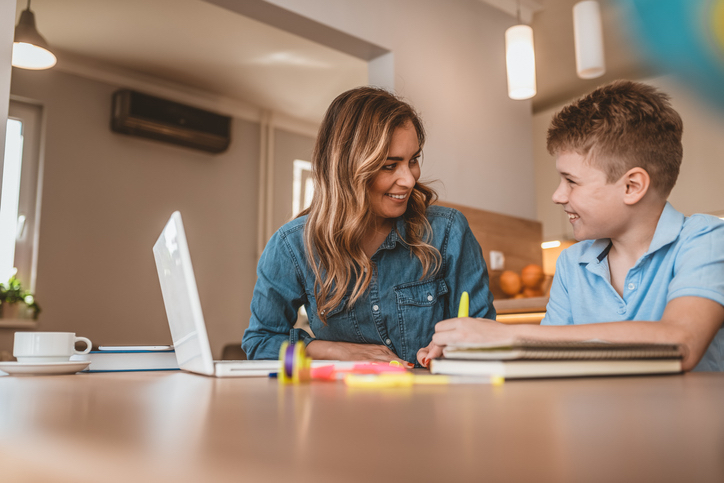
March 23, 2020, by jicke
Helping and homeschooling children in the time of the Coronavirus pandemic
With the unprecedented nationwide closure of schools in response to the current Coronavirus crisis, hundreds of thousands of children will be forced to learn from home.
Professor Nicola Pitchford and Anthea Gulliford from the University of Nottingham’s School of Psychology highlight some of the things to bear in mind when helping children at home in this challenging time, and offer guidance on some resources that can support children’s learning.
Being at home and wellbeing
Children of all ages are likely to feel uncertainty or anxiety at some stage, in different ways, through being away from school and through the changes to their social environment. Being mindful of the following points can help:
- Place wellbeing first. Be attuned and available to talk with children and young people when they want to raise questions about what is happening. Be honest, bearing in mind the child’s age: reassure them, as much as you are able.
- Consider whether it may be helpful to filter access to newsfeeds. Focus on news of the strengths in the community, the helping, and the positive actions people are taking.
- Recognise the potential for the disruption to the child’s school experiences, hopes and anticipations to be experienced as a loss: potentially particularly acute for those in Years 6, 11 or 13 who were due to mark transitions.
- Foster a young person’s sense of connection with their school community as far as possible: with staff and with peers, through virtual learning platforms or social media. Attend to messages from schools that update the school community on any developments.
- Help the young person keep in social contact with their friendship groups, through social media, and phone/video calling. Aim for physical distancing rather than social distancing.
- Visit the outdoors safely, when possible.
- Look after yourself, and manage your own wellbeing.
Learning at home
- Children and young people benefit from some kind of structure and routines. Break the day into shorter periods, varying activities. As much as routine is helpful, variety is good.
- Allow for plenty of flexibility within routines. Adapt, when things do not go to plan.
- Support your child to plan the day ahead, and to engage in making choices and decision-making.
- Schedule breaks, including physical activity.
- Aim to motivate rather than demand: avoid overload.
- Play or active learning provide valuable learning opportunities: follow your child’s interests, motivations and creativity.
- When working on key skills, for younger children especially, consider spacing key learning activities in shorter intervals across the day, rather than in long blocks. Revisit recently learned skills.
- Praise and positive feedback are important to learning. Praise activity and effort, not just when things go right. Celebrate new responsibilities taken.
Schools and educational websites are offering plentiful guidance on curricula and activities (see below). One way to support children’s learning whilst they are at home is through accessing high-quality online educational apps.
Educational apps
Many classrooms in the UK use touch-screen tablets and educational apps to support and engage children in the learning process.
What makes an educational app high-quality?
Our research has identified several features of educational apps that are associated with raising learning outcomes. When choosing educational apps, we recommend looking for apps that:
- follow a well-structured and staged curriculum
- teach basic skills step-by-step without skipping over content
- teach content in different ways through game-like activities
- actively engage children through playful learning
- provide immediate feedback (positive and negative) and motivating rewards
- draw on multisensory processing, enabling children to interact through the visual, auditory and kinaesthetic domains
- allow children to progress at their own pace
- enable children to repeat information as often as they need
- demonstrate ‘how to’ then allow children to ‘practice’ after which they are ‘tested’ on their knowledge
- assess what has been learned before enabling children to progress to high-levels of skill activities
- are scientifically shown to improve learning outcomes.
Links to resources
Here are some links to online resources that can be accessed to support home learning.
Department for Education
- Parental guidance on choosing apps for the home learning environment. https://www.gov.uk/government/publications/early-years-apps-pilot-home-learning-environment/home-learning-environment-early-years-apps-parent-guidance
- Suggestions for activities suitable for 0-5 years of age:
https://hungrylittleminds.campaign.gov.uk/
UNESCO
A list of educational applications and platforms to help parents, teachers, schools and school systems facilitate children’s learning and provide social caring and interaction during periods of school closure. While these solutions do not carry UNESCO’s explicit endorsement, they tend to have wide reach, a strong user-base and evidence of impact. Most of the solutions are free and several support multiple languages.
https://en.unesco.org/themes/education-emergencies/coronavirus-school-closures/solutions
Times Education Supplement
Published article by Julien Grenier that provides information on how to support children in EYFS during the COVID-19 school closures. The section on Assisting in home-schooling provides some useful links for parents.
Enabling Environments
Our teaching partner at Burton Joyce Primary School – Marc Faulder (Early Years Specialist and Apple Distinguished Educator) – has lots of suggestions for how technology can be used to support children’s learning, especially in the early years.
https://enabling-environments.co.uk/
No comments yet, fill out a comment to be the first

Leave a Reply